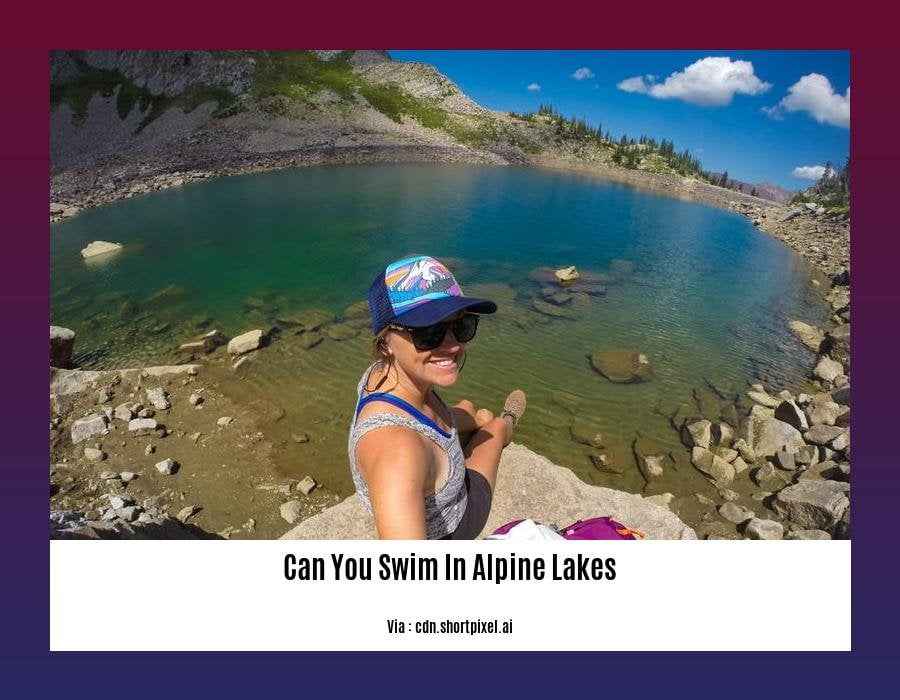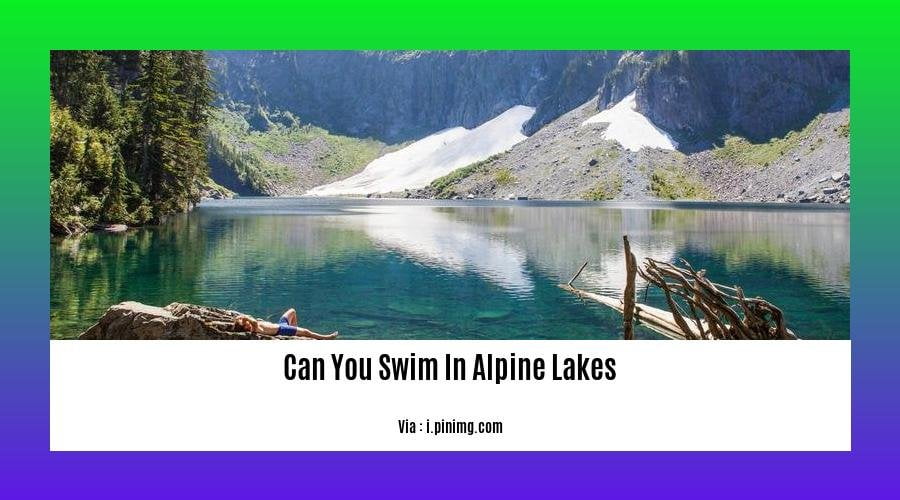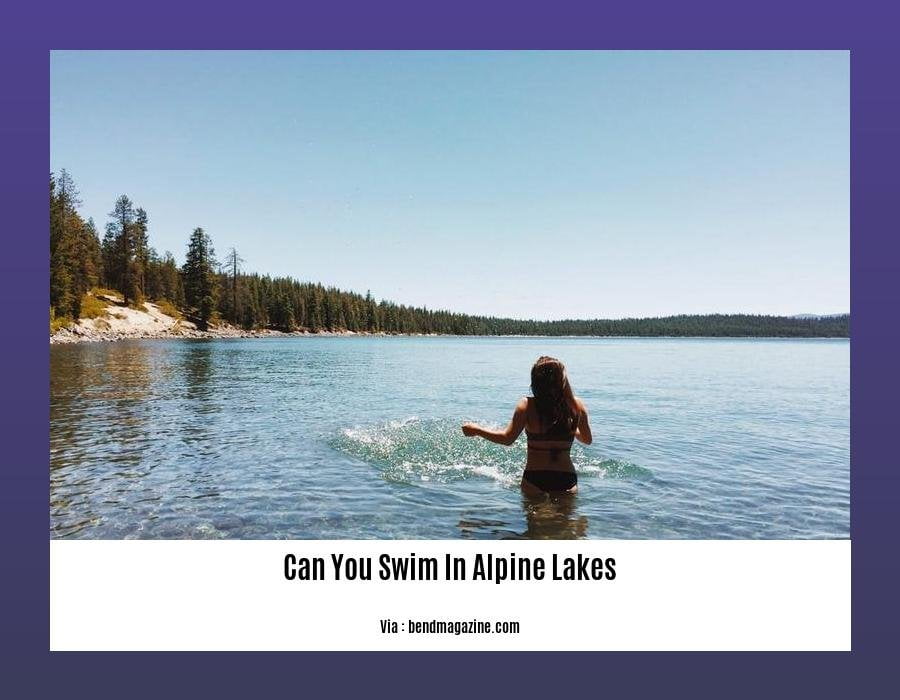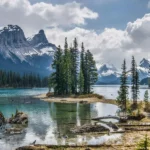If you’ve ever wondered whether swimming in alpine lakes is a possibility, this article, titled “Can You Swim in Alpine Lakes? Exploring the Pristine Beauty and Safety Considerations,” is here to provide you with the answers you seek. As an avid outdoor enthusiast and experienced nature writer, I’ve dedicated myself to exploring and documenting the breathtaking wonders of alpine landscapes. Join me as we delve into the pristine beauty of these crystal-clear lakes, while also understanding the vital safety considerations that come with taking a dip in these natural treasures. Let’s embark on an adventure that will inspire and ensure responsible enjoyment of these delicate ecosystems.
Key Takeaways:
- Swimming in alpine lakes in Colorado is generally not recommended due to freezing temperatures and slippery lake bottoms.
- Most alpine lakes in Colorado are fed by snowmelt, resulting in extremely cold water temperatures.
- The lake bottom is often rocky and slippery, which poses risks for swimmers.
- It is advised to avoid wearing sunscreen while swimming in alpine lakes to protect the delicate ecosystem.
- There are other lakes in Colorado that are more suitable for swimming.
- In Rocky Mountain National Park, it is legal to swim in alpine lakes except for Bear Lake.
- The water in these lakes is typically freezing, with rocky or muddy lake bottoms and the presence of leeches.
- Rocky Mountain National Park offers 17 lakes that are worth visiting.
- Ice Lake is a popular alpine lake hike in Colorado known for its brilliant blue waters.
Can You Swim in Alpine Lakes?

Alpine lakes are an exquisite wonder of nature, nestled amidst towering peaks and pristine wilderness. The temptation to dive into their crystal-clear waters and immerse oneself in their serene beauty is undeniable. However, as an experienced outdoor enthusiast and nature writer, I must guide you through the important considerations when contemplating a swim in these enchanting alpine lakes.
Temperature and Slippery Lake Bottoms
When it comes to swimming in alpine lakes, one must be prepared for the icy grasp of freezing temperatures. Most alpine lakes in Colorado, for example, are fed by snowmelt, resulting in water temperatures that are not suitable for a leisurely dip. The bone-chilling cold can be a shock to the system, posing serious risks to one’s well-being. Additionally, the lake bottoms are often rocky and slippery, making it perilous for swimmers to navigate their depths.
Delicate Ecosystems and Responsible Tourism
Alpine lakes are home to delicate ecosystems, where even the tiniest disturbance can have a lasting impact. To protect these fragile ecosystems, it is advised not to wear sunscreen while swimming in alpine lakes. The chemicals in sunscreen can seep into the water, disrupting the balance of aquatic life and endangering the very beauty we seek to appreciate. We must be responsible stewards of these natural treasures, preserving them for future generations.
Suitable Alternatives and Legal Swimming Areas
Although swimming might not be advisable in many alpine lakes, fear not, for there are alternatives. Colorado boasts numerous lakes that are more suitable for swimming, offering better water temperatures and safer conditions. Rocky Mountain National Park, for instance, allows swimming in most of its alpine lakes, with the exception of Bear Lake. These lakes, however, still present challenges with their freezing waters, rocky or muddy lake bottoms, and the occasional presence of leeches.
It’s worth noting that Rocky Mountain National Park alone is home to 17 stunning lakes that are definitely worth visiting. One such gem is Ice Lake, renowned for its brilliant blue waters. So while swimming might be limited in some alpine lakes, the allure of these magnificent bodies of water remains.
Conclusion
In conclusion, when contemplating a swim in alpine lakes, safety and respect for the environment should always be paramount. The chilly waters and slippery lake bottoms of many alpine lakes in Colorado make them unsuitable for swimming. Instead, consider exploring the numerous lakes in Colorado that are more accommodating for swimming. Remember, responsible tourism ensures the preservation of these natural wonders for generations to come. So, as you venture into the breathtaking alpine landscapes, let the beauty of these lakes inspire you to treasure and protect them.
Can you drive through Death Valley right now? Find out by clicking here.
Curious about swimming in Emerald Cove? Discover the answer by clicking here.
Ever wondered if you can swim in Florida lakes? Click here to find out!
The Potential Risks and Challenges of Swimming in Alpine Lakes

Key Takeaways:
– Alpine lakes may harbor bacteria, parasites, or harmful algae that pose health risks for swimmers.
– While the majority of alpine lakes are safe for swimming, it is important to be cautious and avoid swallowing the water.
– Precautions should be taken when swimming in alpine lakes to ensure safety and prevent health issues.
– Open water swimming in lakes is different from swimming in pools due to factors such as weather conditions, water temperature, reduced visibility, and wildlife.
– Health problems after swimming, such as allergic reactions, skin rashes, and headaches, can be caused by algae, plants, caterpillars, or bacteria present in the water or on the beach.
– Adhering to safety guidelines and being aware of the surroundings can significantly reduce the risks associated with swimming in alpine lakes.
Swimming in alpine lakes is a tempting prospect, as their crystal-clear waters beckon with their pristine beauty. However, it’s essential to be aware of the potential risks and challenges that come with taking a dip in these breathtaking natural wonders. Let’s explore the precautions and considerations you need to keep in mind before diving into alpine lakes.
Understanding the Potential Risks
Alpine lakes, despite their aesthetic charm, may not always be as inviting as they appear. They can harbor unseen dangers in the form of bacteria, parasites, or harmful algae. While many alpine lakes are safe for swimming, it’s crucial to exercise caution and minimize the risk of exposure to these potential threats.
Health Risks and Safety Precautions
One of the most significant risks associated with swimming in alpine lakes is the presence of pathogens that cannot always be visually detected. These pathogens can cause health issues if ingested or come into contact with open wounds. To protect yourself, it is advisable to avoid swallowing the water and consider using appropriate swimwear to reduce the risk of skin infections.
It’s also important to be aware that alpine lakes may have turbid water, which can reduce visibility and make it challenging to assess the lake’s depth or potential hazards that may be lurking beneath the surface. Taking precautions, such as entering the water slowly and assessing the surroundings, can help prevent injuries caused by underwater obstacles.
Unique Considerations for Open Water Swimming
Swimming in alpine lakes is different from swimming in controlled environments such as pools. Factors like weather conditions, water temperature, reduced visibility, and wildlife add to the challenges of open water swimming. It is essential to be prepared for these unique conditions and adapt your swimming approach accordingly. Always check the local weather forecast and water temperature before swimming, and be mindful of sudden changes that can impact your safety.
Addressing Potential Health Issues
In some cases, swimmers may experience health problems after swimming in alpine lakes. Allergic reactions, skin rashes, and headaches can result from exposure to algae, plants, caterpillars, or bacteria present in the water or on the beach. If you encounter any health issues after swimming, it is crucial to consult a medical professional for proper evaluation and treatment.
Swimming with Caution and Respect
Approaching swimming in alpine lakes with caution is vital for ensuring your safety and the preservation of these natural wonders. Before diving into any alpine lake, always assess the depth and potential hazards to avoid accidents. Adhering to safety guidelines, such as swimming in designated areas and respecting nature reserves, can go a long way in minimizing the risks associated with swimming in alpine lakes.
While there are potential risks and challenges involved in swimming in alpine lakes, with proper knowledge and responsible behavior, you can enjoy these magnificent natural wonders while ensuring your safety and the preservation of their delicate ecosystems.
Suggested Article URL Sources:
- ASO – Adventure Sports Outpost: Are Mammoth Lakes Safe for Swimming
- NCESC – Employment Security Commission: Are Alpine Lakes Safe to Swim In
Tips for Safely Enjoying a Swim in Alpine Lakes
Alpine lakes are a haven for outdoor enthusiasts, offering stunning natural beauty and the opportunity for a refreshing swim. However, it’s important to prioritize safety while indulging in these pristine environments. Here are some essential tips to ensure a safe and enjoyable swimming experience:
Stay Weather Aware
The weather in alpine regions can change rapidly, so it’s crucial to check the forecast before heading out and be prepared for unexpected changes. Dress appropriately for the conditions and bring rain gear to stay dry and comfortable.
Dress Appropriately
Layering is key when it comes to dressing for alpine lake excursions. The temperature can vary significantly throughout the day, so wearing multiple layers allows you to adjust to changing conditions and stay comfortable.
Stay Hydrated and Nourished
Alpine environments can be physically demanding, so it’s essential to bring enough water and snacks to stay hydrated and energized during your outdoor adventures. Take care of your body’s needs to ensure you have the energy for a safe and enjoyable swim.
Know Your Limits
Alpine environments can present various challenges, including steep terrain and high altitudes. It’s important to be aware of your physical capabilities and not push yourself beyond your limits. Take breaks when needed and listen to your body to avoid overexertion.
Wildlife Safety
While enjoying the beauty of alpine lakes, it’s important to be aware of wildlife, especially bears and mountain lions. Educate yourself on how to safely encounter and coexist with wildlife. Store food properly to avoid attracting animals to your campsite.
Emergency Preparedness
Always carry a basic first aid kit and know how to use it. Additionally, make sure to have a map, compass or GPS, and a whistle to navigate and communicate in case of emergencies.
With these Tips for safely enjoying a swim in alpine lakes, you can have a safe and memorable experience while exploring the breathtaking beauty of these natural wonders.
Key Takeaways:
- Stay weather aware and dress appropriately for changing conditions.
- Stay hydrated and nourished to meet the physical demands of swimming in alpine lakes.
- Know your limits and don’t push yourself beyond what you’re physically capable of.
- Be aware of wildlife and follow guidelines for safe encounters.
- Be prepared for emergencies with a first aid kit and navigation tools.
URL Sources:
1. ASO – Adventure Sports Outpost
2. NCESC – Employment Security Commission
The Importance of Preserving the Pristine Nature of Alpine Lakes
Alpine lakes hold a special place in our natural world, offering breathtaking beauty and incredible recreational opportunities. However, it is of utmost importance that we prioritize the preservation of these pristine environments. By understanding the delicate ecosystems and taking responsible actions, we can ensure the long-term conservation of alpine lakes for future generations to enjoy.
Alpine lakes, such as Independence Lake in California and the stunning lakes of Colorado, are not just picturesque landscapes. They are home to unique and fragile ecosystems that support a diverse range of plant and animal species. These lakes are havens for native fish and wildlife, serving as critical habitats for species like the Lahontan cutthroat trout. Preserving these habitats is crucial to maintaining their delicate balance and preserving biodiversity.
Key Takeaways:
– Alpine lakes are home to unique and fragile ecosystems that support diverse plant and animal species.
– Preserving these habitats is crucial for maintaining biodiversity and protecting native fish and wildlife, like the Lahontan cutthroat trout.
Furthermore, alpine lakes play a vital role in preserving the serenity of nature’s peaks and provide us with natural beauty that is unparalleled. They serve as reservoirs of paleoclimate data, offering valuable insights into past climate variability. The conservation of these lakes allows us to better understand our planet’s history and climate patterns, aiding in scientific research and environmental efforts.
Key Takeaways:
– Alpine lakes preserve the serenity of nature’s peaks and offer unparalleled natural beauty.
– They provide valuable paleoclimate data, contributing to scientific research and our understanding of climate variability.
However, these magnificent bodies of water face significant risks and challenges. The introduction of invasive species, such as quagga mussels and Eurasian water-milfoil, poses a severe threat to the delicate balance of alpine lake ecosystems. These invasions can disrupt the natural habitats, impact native species, and compromise water quality.
To preserve the pristine nature of alpine lakes, it is crucial that we take proactive measures to prevent the introduction and spread of invasive species. Organizations like The Nature Conservancy play a vital role in acquiring and protecting critical habitats, implementing forest management strategies, and reducing the risk of invasive species introduction.
Key Takeaways:
– Invasive species pose a significant threat to alpine lake ecosystems and water quality.
– It is essential to take proactive measures to prevent the introduction and spread of invasive species.
– Organizations like The Nature Conservancy play a crucial role in protecting alpine lake habitats and implementing conservation strategies.
As outdoor enthusiasts and visitors to alpine lakes, we must also prioritize responsible tourism and recreational practices. Safety considerations, such as staying informed about weather conditions and dressing appropriately, are essential for a safe and enjoyable experience. Additionally, respecting wildlife and following guidelines for encounters can help maintain the delicate balance of these ecosystems.
By understanding the importance of preserving the pristine nature of alpine lakes and adopting responsible practices, we can ensure the long-term conservation of these natural treasures. Let us appreciate the beauty of alpine lakes while actively working to protect and preserve them for future generations.
Key Takeaways:
– Responsible tourism and recreational practices are essential for preserving alpine lakes.
– Safety considerations, such as staying informed about weather conditions and respecting wildlife, are crucial.
– By adopting responsible practices, we can ensure the long-term conservation of alpine lakes.
URL Source:
– The Nature Conservancy: Independence Lake Preserve | The Nature Conservancy in CA
FAQ
Q1: Are alpine lakes in Colorado safe for swimming?
A1: While swimming in alpine lakes in Colorado is possible, it is not recommended due to freezing temperatures and slippery lake bottoms. Most alpine lakes in Colorado are fed by snowmelt, resulting in extremely cold water temperatures. Additionally, the lake bottom can often be rocky and slippery, posing potential dangers for swimmers.
Q2: Can I wear sunscreen while swimming in alpine lakes?
A2: It is advised not to wear sunscreen while swimming in alpine lakes to avoid disrupting the fragile ecosystem. Alpine lakes are home to delicate ecosystems, and the chemicals in sunscreen can have adverse effects on the plants and animals that rely on the lake for survival.
Q3: Are there other lakes in Colorado that are suitable for swimming?
A3: Yes, there are other lakes in Colorado that are more suitable for swimming. While swimming in alpine lakes is generally not recommended, there are lakes in Colorado that have warmer water temperatures and more accessible lake bottoms, making them safer and more enjoyable for swimming.
Q4: Can you legally swim in alpine lakes in Rocky Mountain National Park?
A4: Yes, you can legally swim in alpine lakes in Rocky Mountain National Park, except for Bear Lake. However, it is important to note that the water in these lakes is often freezing, with rocky or muddy lake bottoms and the presence of leeches. It is essential to exercise caution and be aware of the potential risks associated with swimming in these lakes.
Q5: How many alpine lakes are worth visiting in Rocky Mountain National Park?
A5: Rocky Mountain National Park is home to 17 lakes that are worth visiting. These lakes offer stunning beauty and unique opportunities for outdoor adventures. However, it is important to note that swimming in these lakes may not be suitable due to factors such as water temperature and lake bottom conditions.
- Unveiling Bernhard Caesar Einstein’s Scientific Achievements: A Legacy in Engineering - July 15, 2025
- Uncover who is Jerry McSorley: CEO, Family Man, Business Success Story - July 15, 2025
- Discover Bernhard Caesar Einstein’s Scientific Contributions: Unveiling a Legacy Beyond Einstein - July 15, 2025















